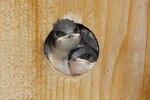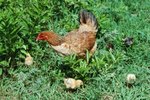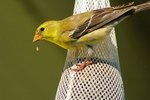
Mourning doves are prolific breeders, but their young have a high mortality rate. They're found in rural areas throughout the United States. In some states they're hunted as game birds, while in others they're protected as song birds. Mourning doves (Zenaida macroura) are sloppy nest builders, loosely joining sticks and twigs to form a nest that is easily knocked to the ground by winds and storms.
Abandoned Newborns
Baby doves that have fallen from their nest can be replaced. The parents will not abandon them because you've touched them. If you find newborn mourning doves whose nest has fallen to the ground, you may be able to repair and replace the nest. Observe the nest to be sure the parents return to care for the babies. Another alternative is to hand-feed the babies until they're weaned. Raising baby birds is about a four-week commitment. Mourning doves are gentle, affectionate birds that will reward you for your efforts.
Habitat for Newborns
Baby mourning doves must be kept clean and warm until they are feathered. A box lined with paper towels is easy to keep clean. Add dried grass or straw as a nesting material. Start with a temperature of 95 degrees, and lower it by one degree each day. A low-wattage red light bulb, a red basking bulb or a reptile heating pad are suitable heat sources. Don't use clear or white light bulbs; these are blinding to the babies sensitive eyes. Dry abdominal skin indicates dehydration and too much heat.
Hand-Feeding
Proper nutrition is essential for healthy babies. A baby bird formula made for squab provides the needed nutrients. Follow the package directions for age appropriate dilution and scheduling. Baby doves don't open their mouths or chirp at feeding time like other birds, instead rooting around with their beaks in search of food. They suck food through their beaks, as if they're using a straw. Don't put food into their mouths; aspiration is a real danger with baby doves. Offer food on a teaspoon and let them suck the formula.
Parental Care of Fledglings
Baby mourning doves are pushed from the nest by their parents when they're about 2 weeks old. The parents will continue to feed them on the ground until the babies are weaned at about 4 weeks old, unless they begin another clutch. If you find feathered baby doves on the ground, observe them to be sure they're being cared for. If the babies are abandoned by their parents, hand-feeding them is an option.
Wild Animal Rehabilitation
In many states, it's illegal to raise wild animals, including birds. Check with a local veterinarian or your state's Fish and Wildlife Department for local regulations. Wildlife rehabilitators and bird rescue organizations are often available.
References
Photo Credits
-
Tom Brakefield/Stockbyte/Getty Images
Writer Bio
Karen Mihaylo has been a writer since 2009. She has been a professional dog groomer since 1982 and is certified in canine massage therapy. Mihaylo holds an associate degree in human services from Delaware Technical and Community College.




